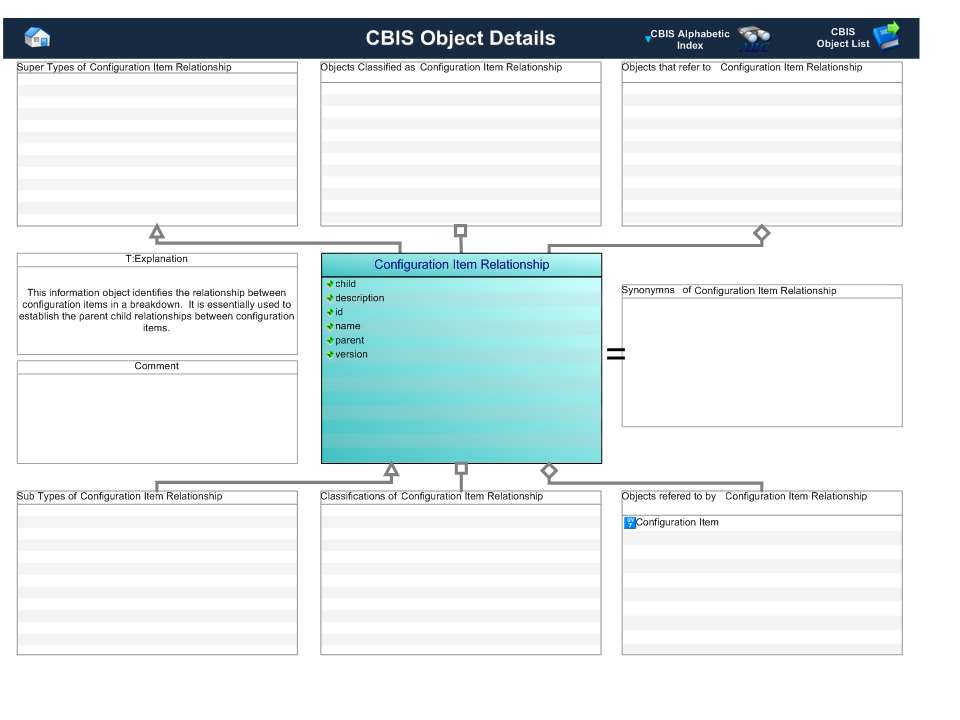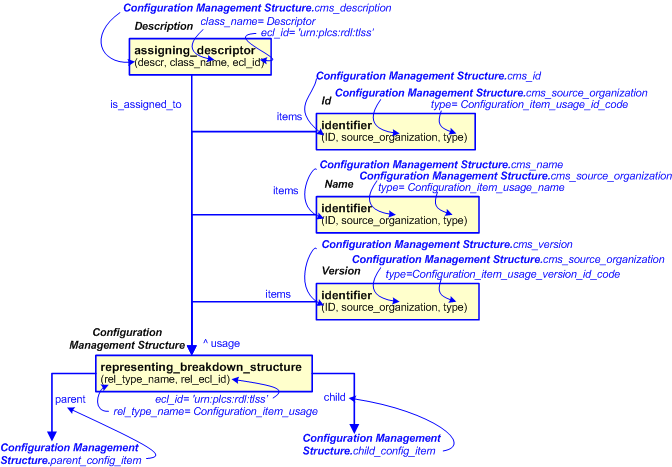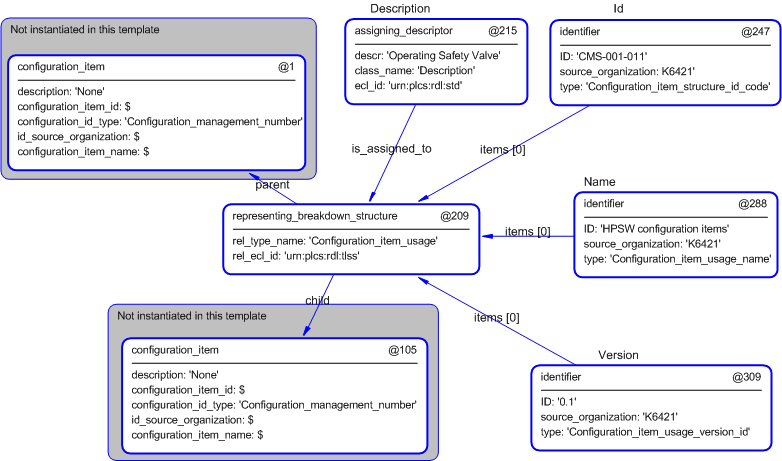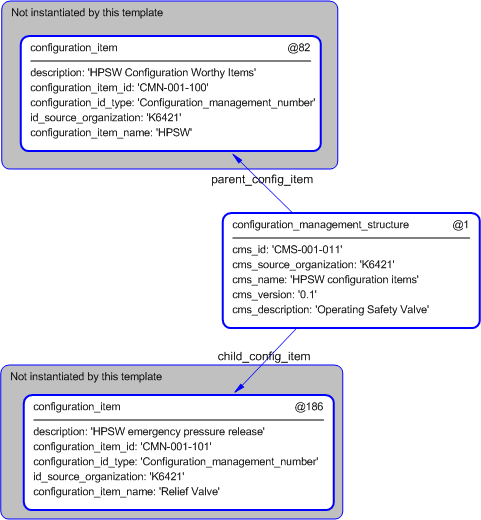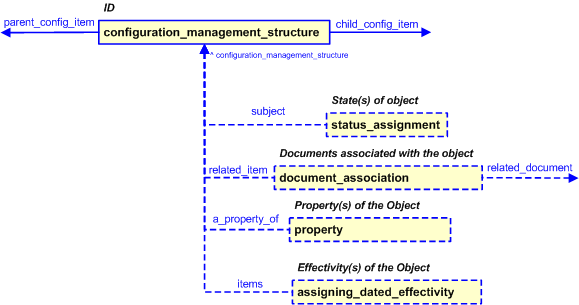Template:— configuration_management_structure (cnfg_mgt_strct)
Context:— UK_Defence |
Date: 2009/04/17 10:42:11
Revision: 1.2
|
This section specifies the template configuration_management_structure.
NOTE
The template has been defined in the context of
UK_Defence.
Refer to the business context for details of related templates.
NOTE
An explanation of a template and the associated instantiation path is
provided in the
Template overview
section.
This template describes how to represent the UK_Defence concept of a configuration item relationship (as a configuration management
structure)
in terms of PLCS model elements (templates, entities, and reference data).
This information object identifies the relationship between configuration items in a breakdown. It is essentially
used to establish the parent child relationships between the configuration items.
This information object identifies the relationship between configuration items in a breakdown. It is essentially
used to establish the parent child relationships between the configuration items.
Figure 1 — Graphical Representation for Business Object Configuration Item Relationship
|
Attribute name
|
Attribute description
|
Attribute type
|
Optionality
|
| child |
This attribute identifies the child node in a hierarchical relationship. |
Configuration Item |
Mandatory |
| description |
This attribute provides the description of the configuration item relationship. |
Intrinsic |
Mandatory |
| id |
This attribute provides the identifier of the configuration item relationship. |
Identifier |
Mandatory |
| name |
This attribute provides the name of the configuration item relationship. |
Intrinsic |
Mandatory |
| parent |
This attribute specifies the parent or upper node in a hierarchical relationship. |
Configuration Item |
Mandatory |
| version |
This attribute provides the version of the configuration item relationship. |
Intrinsic |
Mandatory |
Table 1 — Configuration Item Relationship attribute details
The EXPRESS-G diagram in
Figure
2
shows the templates and EXPRESS entities that are required
to represent the template
"configuration_management_structure".
The text highlighted in blue shows the template parameters.
The text in bold blue indicate the template parameters; the light blue indicates parameter values set within the template.
Figure 2 — An EXPRESS-G representation of the Information model for configuration_management_structure
The graphic for the template to be used in other EXPRESS-G diagrams
is shown in Figure
3
below.
Figure 3 — The graphical representation of the configuration_management_structure template
The following input parameters are defined for this template:
The identifier of the configuration management structure relationship.
The organization or information system that created the associated identifier. Alternatively this could be set to /NULL when
Person or Information System is the source; see Identifier template characterizations.
The name of the configuration management structure relationship.
The version identifier of the configuration management structure relationship.
This attribute provides the description of the Item.
The parent breakdown element definition that is classed as a Configuration item.
The child breakdown element definition that is classed as a Configuration item
The following reference parameters are defined for this template:
%^target = $configuration_management_structure.configuration_management_structure%
The instantiation path shown below specifies the entities that are to be
instantiated by the template.
A description of templates and the syntax for the instantiation path is
provided in the
Templates Help/Information section.
/
representing_breakdown_structure(
rel_type_name='Configuration_item_usage',
rel_ecl_id='urn:plcs:rdl:uk_defence',
parent=@parent_config_item,
child=@child_config_item)/
%^configuration_management_structure = $representing_breakdown_structure.usage%
/
identifier(
items=^configuration_management_structure,
ID=@cms_id,
type='Configuration_item_usage_id_code',
source_organization=@cms_source_organization)/
/
identifier(
items=^configuration_management_structure,
ID=@cms_name,
type='Configuration_item_usage_name',
source_organization=@cms_source_organization)/
/
identifier(
items=^configuration_management_structure,
ID=@cms_version,
type='Configuration_item_usage_version_id_code',
source_organization=cms_source_organization)/
/
assigning_descriptor(
descr=@cms_description,
class_name='Description',
ecl_id='urn:plcs:rdl:uk_defence',
is_assigned_to=^configuration_management_structure)/
The instance diagram in Figure
4
shows an example of the EXPRESS entities and templates that are instantiated by the template:
/configuration_management_structure(cms_id=''CMS-001-011'', cms_source_organization=' 'K6421'', cms_name=''HPSW configuration items'', cms_version='0.1', cms_description=''Operating Safety Valve'', parent_config_item='@82', child_config_item='@186')/
(an illustration of the consolidated configuration_management_structure template is shown in
Figure
5 below.)
Figure 4 — Entities instantiated by configuration_management_structure template
The instance diagram in
Figure
5
shows the graphic symbol for the template that is to be
used in other instance diagrams. The example template is:
/configuration_management_structure(cms_id=''CMS-001-011'', cms_source_organization=' 'K6421'', cms_name=''HPSW configuration items'', cms_version='0.1', cms_description=''Operating Safety Valve'', parent_config_item='@82', child_config_item='@186')/
Figure 5 — Instantiation of configuration_management_structure template
The following section details how the
configuration_management_structure
template can be optionally characterized by assigning
other constructs to it. These are characterizations commonly
applied to the template. The ISO 10303-239 EXPRESS model may enable
other assignments to the entities instantiated by the template.
The EXPRESS-G diagram in Figure
6
shows the possible characterizations of the template
"configuration_management_structure".
Figure 6 — Characterizations for configuration_management_structure
The following characterizations may apply:
Characterization Property
NOTE this characterization is optional.
A UK_Defence.configuration_management_structure
may have specific properties assigned to it, through the use of the following templates (or those based upon these):
UK_Defence.property. The following template calls show how these characterizations
might be instantiated.
/property(property_identifier='', property_ecl_id='', property_value='', property_unit='', unit_ecl_id='', si_unit='', disposition='', a_property_of='')/
Characterization Status Assignment
NOTE this characterization is optional.
A UK_Defence.configuration_management_structure
may have one or more status assigned to it, through the use of the following templates (or those based upon these):
UK_Defence.status_assignment.
The following template calls show how these characterizations
might be instantiated.
/status_assignment(assigned_status='', assigned_status_ecl_id='', ID='', ID_type='', ID_organization='', subject='', type='', type_ecl_id='')/
Characterization Document Association
NOTE this characterization is optional.
Characterization Assigning effectivity
NOTE this characterization is optional.
An effectivity may be assigned to the UK_Defence.configuration_management_structure.
This shall be done using entity Effectivity_assignment.
For example, a dated effectivity shall be assigned using template assigning_dated_effectivity.
/assigning_dated_effectivity(start_year='2005', start_month='11', start_day='22', start_hour='15', start_minute='15', start_second='00', start_sense='ahead', start_hour_offset='2', role_class_name='Planned_effectivity', role_ecl_id='urn:plcs:rdl:std', items='@@@@')/
NOTE
The type of effectivity is described through the application of reference data. In this case the reference data specifies
that it is a 'Planned Effectivity', but other types (e.g. 'Required' and 'Actual Effectivty' exist
NOTE
The assignment of effectivities is described in capability C006: assigning_effectivity.
